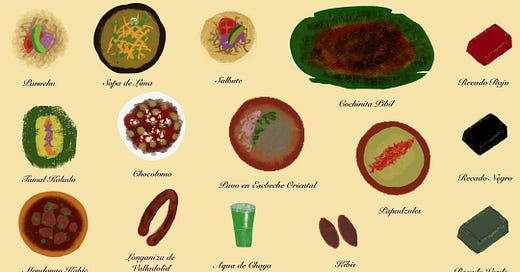Mexico's Northern Yucatán Peninsula
Typical foods from around Mérida, Valladolid & Izamal.
The following story is the second in a regular feature in this newsletter for paid subscribers. The format is similar to the Ecosystems stories, which describe the ingredients from a particular landscape, however, Regional Foods describe how they are being used together.
A triangular shaped state, the Yucatán, sits on Mexico’s Gulf Coast at the northern end of the Yucatán Peninsula. While there has been an industry-wide push to recognize the Yucatán’s contributions to Mexican gastronomy in recent years, it would be false to consider it an emerging cuisine. Many of the recipes mentioned here partially date to the time of the Maya, while Spanish colonial influences are mellowed by the addition of influences from the wider Caribbean and even Lebanon.
Like elsewhere in Mexico, corn, squash, tomatoes and beans feature prominently in Yucatecan food, but they exist alongside the flavors of habanero and xcatik chiles, sour oranges (Seville oranges) and achiote seeds that are used just as frequently. The climate is more tropical here, with a considerable amount of dense jungle, adding fruits unseen in other parts of Mexico, not to mention plenty of game meats, like turkey and deer (which is mostly farm raised now). The gulf facing northern front of the state offers relatively easy access to a plethora of fish, not to mention octopus, which are caught using an ancestral technique that is far more sustainable than modern fisheries.
This guide will help you know the differences between the region’s recados, understand why earthen pits make good ovens and why Dutch cheese is so common. The majority of the foods described here were seen in markets, street stalls and typical restaurants in and around Mérida, as well as smaller towns like Izamal and Valladolid. While these recipes are some of the better known from this corner of Mexico, there are many more I am unable to mention.
Keep reading with a 7-day free trial
Subscribe to New Worlder to keep reading this post and get 7 days of free access to the full post archives.




